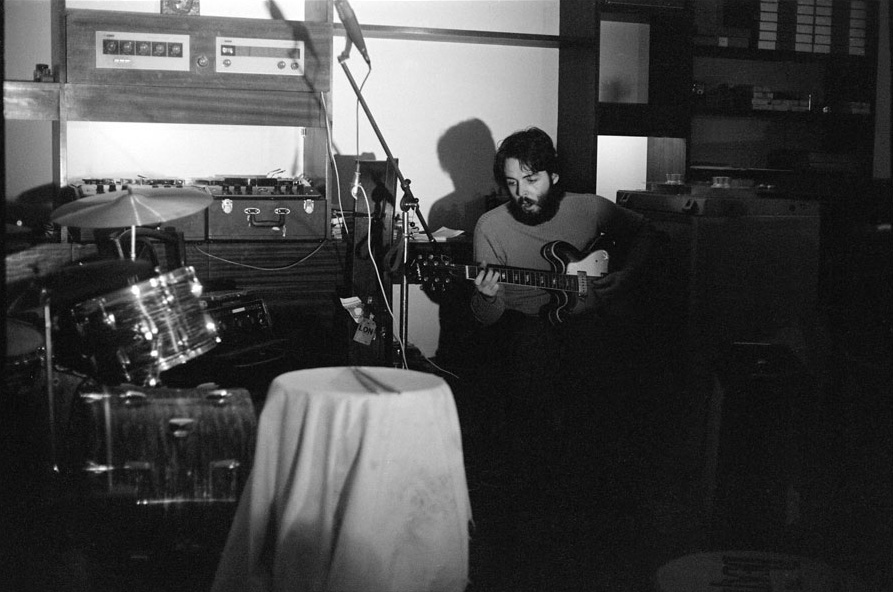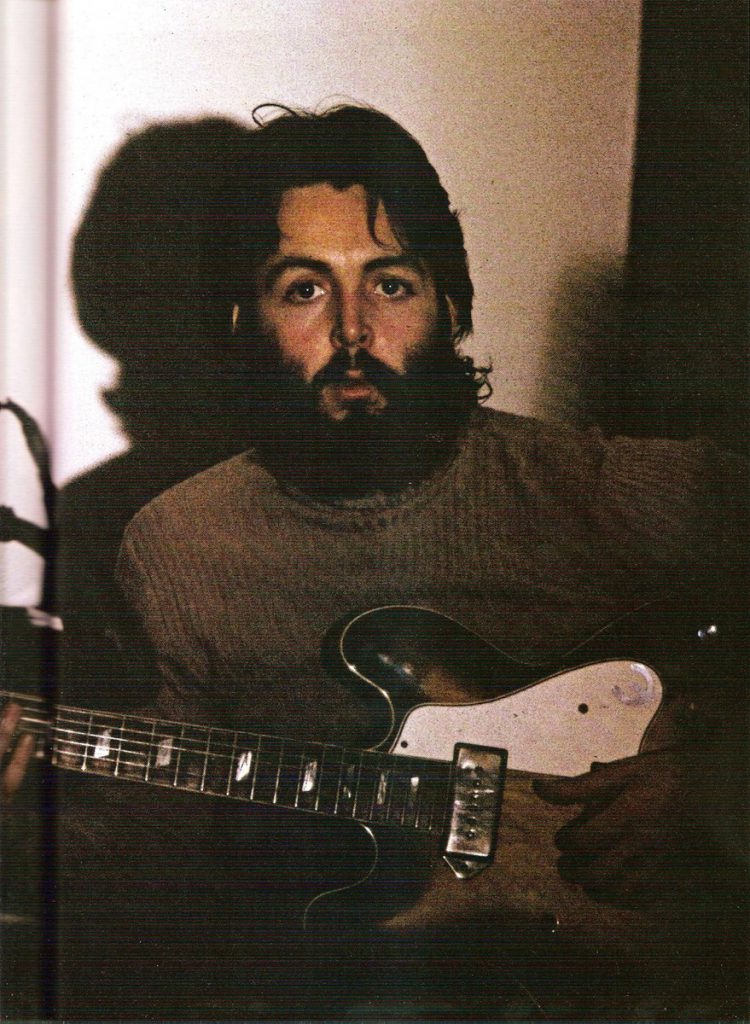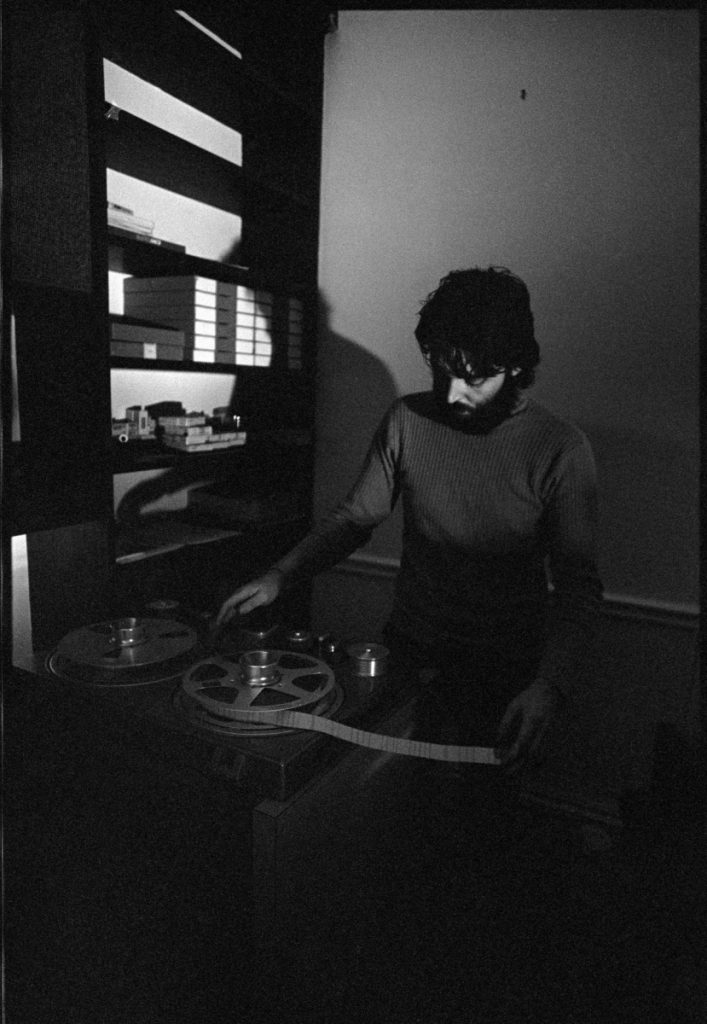Late December 1969 to Jan 03, 1970
"McCartney" home recordings
For Paul McCartney
Last updated on April 1, 2022
Late December 1969 to Jan 03, 1970
For Paul McCartney
Last updated on April 1, 2022
Recording studio: At home, Cavendish Avenue, St. John's Wood, UK
Session Dec 15, 1969 • Mixing the "Get Back" album (4th compilation)
Single Dec 19, 1969 • "The Beatles Seventh Christmas Record" by The Beatles released in the UK
Session Late December 1969 to Jan 03, 1970 • "McCartney" home recordings
Session Dec 21, 1969 • Mixing the "Get Back" album (4th compilation)
Article Dec 25, 1969 • Rooftop "Get Back" video clip broadcast in color in the UK
Some of the songs worked on during this session were first released on the "McCartney" LP.
In October 1969, after John Lennon told the other Beatles he was leaving the band, Paul and Linda McCartney escaped London to isolate themselves and their two daughters (Heather and baby Mary) on their Scottish farm. It was a period of depression for Paul.
I was going through a hard period. I exhibited all the classic symptoms of the unemployed, the redundant man. First, you don’t shave, and it’s not to grow a groovy beard, it’s because you cannot be fucking bothered. Anger, deep deep anger sets in, with everything, with yourself number one, and with everything in the world number two. And justifiably so because I was being screwed by my mates. So I didn’t shave for quite a while. I didn’t get up. Mornings weren’t for getting up. I might get up and stay on the bed a bit and not know where to go, and get back into bed. Then if I did get up, I’d have a drink. Straight out of bed. I’ve never been like that. There are lots of people who’ve been through worse things than that, but for me this was bad news because I’d always been the kind of guy who could really pull himself together and think, “Oh, fuck it,” but at that time I felt I’d outlived my usefulness.
Paul McCartney – From “Solid State” by Kenneth Womack
They stayed in Scotland from late October to mid-December 1969. They then went on holiday in Antigua, where the photograph used for the cover of the “McCartney” album was taken. Back in London, in late December, Paul started recording his first solo album at home.
I really had to ask myself, “Do I want to give up music, or keep going?” I got a four-track Studer recording machine, like the Beatles used for Sgt. Pepper, put it in the corner of the living-room at my house in London and tried a very simple technique of just plugging directly into the back, not going through a mixing desk. It’s a cool way to record because it’s pure. If, say, I was doing a drum track, I’d play the drums, record it with one microphone, listen to it back, move the mike a little if there wasn’t enough hi-hat or cymbal, and then re-record. Then I’d add bass by plugging the mike into track two and overdubbing while listening to track one through headphones. I’d do that with all with four tracks. It was very hands-on, primitive way of working. In the opening track, The Lovely Linda, you can hear the door squeak as Linda came in while I was recording. It was a good take, so we left it in. I made the whole McCartney album like that, and when I needed to go further we used a little studio in Willesden called Morgan, just to get a bit more high-tech. But I played all the instruments and we did a few harmonies together. It was funky, and still sounds good to me.
Paul McCartney – From the “Wingspan” documentary, 2001
I was like a professor in his laboratory. Very simple [set-up], as basic as you can get … Even now that album has an interesting sound. Very analogue, very direct.
Paul McCartney, from an interview with Paul Du Noyer (MOJO, July 2001)
The songs recorded for “McCartney” were a combination of left-over songs from The Beatles’ era (“Teddy Boy“, “Junk“, “Hot As Sun“) and new compositions written in Scotland (“The Lovely Linda“, “That Would Be Something“…) or made on the spot.
From Wikipedia:
McCartney and his family returned to London shortly before Christmas 1969, and he started work on the album at his home in Cavendish Avenue, St John’s Wood. The recordings were carried out on a recently delivered Studer four-track tape recorder, without a mixing desk, and therefore without VU displays as a guide for recording levels. In the commentary he later supplied with the album, McCartney described his home-recording set-up as “Studer, one mike, and nerve“.
McCartney first taped a 45-second portion of a song he had written in Campbeltown, “The Lovely Linda“. As with much of the album, McCartney sung the composition accompanied by acoustic guitar before filling the remaining tracks on the Studer with a second guitar part, bass and percussive accompaniment. Although this performance of “The Lovely Linda” was only intended as a test of the new equipment, it would be included on the official release, as the opening track, complete with the sound of McCartney giggling at the end of the recording.
Reflecting the sequencing on the album, the second and third songs McCartney taped were “That Would Be Something“, also written in Scotland, and the instrumental “Valentine Day“. The latter was one of three selections on McCartney that its creator “ad-libbed on the spot”, he later claimed, along with the similarly rock-oriented “Momma Miss America” and “Oo You“.
On 3 January 1970, he interrupted work on McCartney to participate in the Beatles’ final recording session, when he, George Harrison and Ringo Starr recorded the Harrison composition “I Me Mine” at Abbey Road Studios. The next day, the three musicians revisited McCartney’s “Let It Be“, a song recorded by the band in January 1969 for their forthcoming Get Back film project. […]
On February 12, 1970, Paul McCartney took his Studer tapes to Morgan Studios, in the northwest of London, in order to copy all the four-track recordings onto eight-track tape, to allow for further overdubbing.
On February 22, 1970, he moved to the more familiar Abbey Road Studios, to complete the recording and mixing of the new album.
We decided we didn’t want to tell anybody what we were doing. That way it gets to be like home at the studio. No one knows about it, and there is no one in the studio or dropping by.
Paul McCartney – From interview with RollingStone, 1970
After John said he was leaving, I hung on for months, wondering whether The Beatles would ever come back together again and hoping that John might come around and say, ‘All right, lads, I’m ready to go back to work.’ None of us knew what to do, but we decided to wait until about March or April until our film, Let It Be, came out. But I was bored. I like to work. I’m an active person. Sit me down with a guitar and let me go. So, naturally enough, in the meantime, I began to look for something to do. I decided I was not going to sit there, sucking my thumbs, waiting for everyone to come back, so the album McCartney turned out to be the answer in my case. I had just got a new recording machine in my house and I found that I liked working on my own. At first it wasn’t going to be anything serious but it turned out to be a great time. When we had to go to the (Morgan) studios, Linda would make the booking and we’d take some sandwiches and a bottle of grape juice and put the baby on the floor and it was all like a holiday. So, as a natural turn of events, from looking for something to do, I found that I was enjoying working alone as much as I had enjoyed the early days. So, anyway, McCartney came out and Linda and I did it totally, the record, the cover, the ads, everything presented to the record company. Then there started to appear these little advertisements. On the bottom was ‘On Apple Records’, which was okay. But somebody had also come along and slapped on ‘An ABKCO managed company’. Now that is Klein’s company and has nothing to do with my record. It’s like Klein taking part of the credit for my record. All those little things kept happening, such trivia compared to what happened. Maybe that sounds petty, but I can go into other examples of this kind of thing. All these things that are continuously happening makes me feel like I’m a junior with the record company, like Klein is the boss and I’m nothing. Well, I’m a senior… The income from the McCartney album is still being held by Apple and Linda and I are the only ones on the record.
Paul McCartney – From “The Beatles: Off the Record” by Keith Badman
I loved making music and I found that I didn’t want to stop… I found that I was enjoying working alone as much as I had enjoyed the early days of The Beatles.
Paul McCartney – From “And In The End” by Ken McNab
When you were working on “McCartney” in London, was it strange not being able to bounce ideas off the others?
Yeah, it was. Because right up until that point I’d been working with John, the best collaborator in the world. Suddenly that was taken away. It was very difficult. But I thought, ‘Well, I’m not going to worry about it. I’m going to sling some ideas down, have a little go on the drums.’ I had my own stuff at the house for my own fun, I wasn’t going into the studio with The Beatles. I wasn’t sweating it. Then suddenly, it became something. “OK, this is an album.”
Paul McCartney, in UNCUT interview, January 2021
I was feeling quite comfortable, the more I went on like this. I could actually do something again.
Paul McCartney – From interview with RollingStone, 1970




Written by Paul McCartney
Recording • "When the Studer 4-track was installed at home, this was the first song I recorded, to test the machine. On the first track was vocal and guitar, second - another acoustic guitar - then overdubbed hand slaps on a book, and finally bass. Written in Scotland, the song is a trailer to the full song which will be recorded in the future." Track-by-track commentary by Paul McCartney, 1970
AlbumOfficially released on McCartney
Written by Paul McCartney
Recording • "This song was written in Scotland in 1969 and recorded at home in London - mixed later at EMI (No. 2). I only had one mike, as the mixer and VU meters hadn’t arrived (still haven’t). "
AlbumOfficially released on McCartney
Written by Paul McCartney
Recording • "Recorded at home. Made up as I went along - acoustic guitar first, then drums (maybe drums were first). Anyway - electric guitar and bass were added and the track is all instrumental. Mixed at EMI. This one and ‘Momma Miss America’ were ad-libbed, with more concern for testing the machine than anything else."
AlbumOfficially released on McCartney
Written by Paul McCartney
Recording • "An instrumental recorded completely at home. Made up as I went along – first a sequence of chords, then a melody on top. Piano, drums, acoustic guitar, electric guitar. Originally it was two pieces but they ran into each other by accident and became one."
AlbumOfficially released on McCartney
Written by Paul McCartney
Recording • "Originally written in India, at Maharishi's camp, and completed bit by bit in London. Recorded vocal, two acoustic guitars, and bass at home, and later added to (bass drum, snare with brushes, and small xylophone and harmony) at Morgan. "
AlbumOfficially released on McCartney
Written by Paul McCartney
Recording • "The first three tracks were recorded at home as an instrument that might someday become a song. This, like 'Man We Was Lonely', was given lyrics one day after lunch, just before we left for Morgan Studios, where it was finished that afternoon. "
AlbumOfficially released on McCartney
Written by Paul McCartney
Recording • "Another song started in India and completed in Scotland and London, gradually. This one was recorded for Get Back film but later not used. Rerecorded partly at home…(guitar, voices and bass)…and finished at Morgan. Linda and I sing the backing harmonies on the chorus and occasional oos."
AlbumOfficially released on McCartney
Written by Paul McCartney
Recording
AlbumOfficially released on McCartney - Archive Collection
Written by Paul McCartney
Recording • In the liner notes of McCartney - Archive Collection, it is indicated this track was recorded at "Rude Studio (unknown date)", which is inaccurate, as Rude Studio (Paul's recording studio in Scotland) didn't exist early 1970. We assume it was recorded at his London home.
AlbumOfficially released on McCartney - Archive Collection
Written by Paul McCartney
Recording • Rumored unreleased and unsurfaced instrumental
Unreleased track
Written by Paul McCartney
Recording • Rumored unreleased and unsurfaced instrumental
Unreleased track
Written by Paul McCartney
Recording • Rumored unreleased and unsurfaced instrumental
Unreleased track
Eight Arms to Hold You: The Solo Beatles Compendium
We owe a lot to Chip Madinger and Mark Easter for the creation of those session pages, but you really have to buy this book to get all the details!
Eight Arms To Hold You: The Solo Beatles Compendium is the ultimate look at the careers of John Lennon, Paul McCartney, George Harrison and Ringo Starr beyond the Beatles. Every aspect of their professional careers as solo artists is explored, from recording sessions, record releases and tours, to television, film and music videos, including everything in between. From their early film soundtrack work to the officially released retrospectives, all solo efforts by the four men are exhaustively examined.
As the paperback version is out of print, you can buy a PDF version on the authors' website

Notice any inaccuracies on this page? Have additional insights or ideas for new content? Or just want to share your thoughts? We value your feedback! Please use the form below to get in touch with us.
Ben Smeenk • 4 years ago
The recording date for Singalong Junk is given as at home (december 1969). In the list of songs recorded at home (december 1969) this song is not mentioned. At least I cannot see it there.